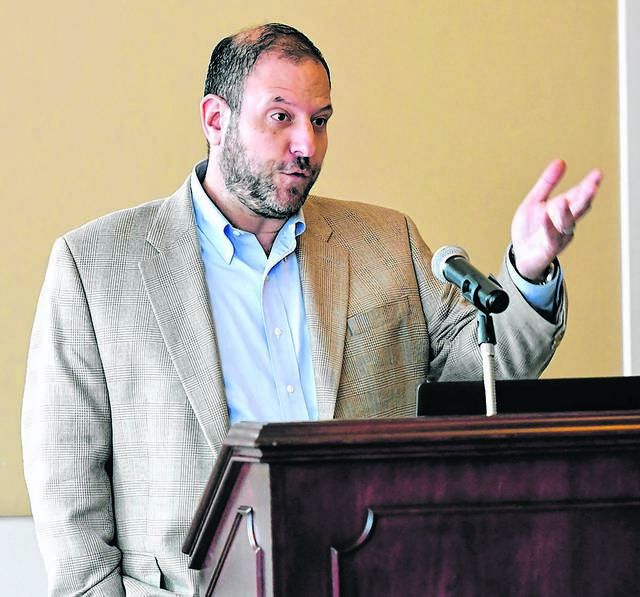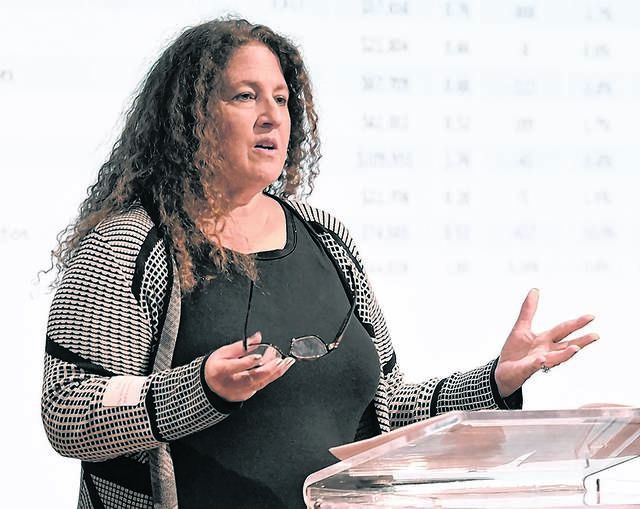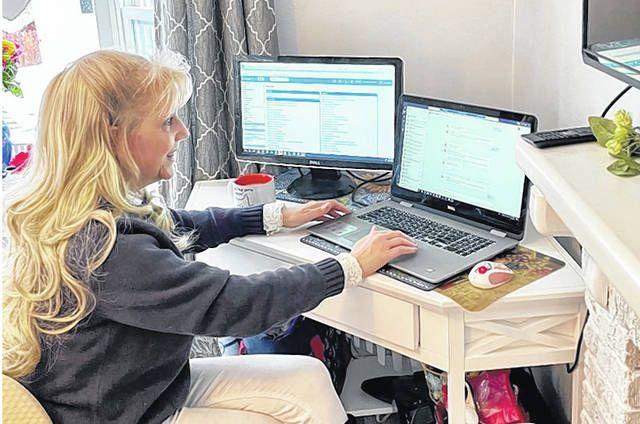Downtowns feeling the crunch of missing workers
Click here to subscribe today or Login.
WILKES-BARRE — In the short-term, working from home during the coronavirus pandemic has had both positive and negative effects on the workforce and the local economy.
One area that seems to have been hardest hit by the extended work-from-home requirement has been Wilkes-Barre City’s downtown.
Two large employers — Berkshire Hathaway GUARD Insurance and Highmark Blue Cross Blue Shield — have had their employees working from home for a year now and there doesn’t seem to be a clear date when they might return to their downtown offices.
“There’s no question that COVID-related work-from-home orders and shutdowns have had a dramatic impact on downtown Wilkes-Barre’s business environment,” said Larry Newman, executive director of the Diamond City Partnership, steward of the downtown. “Downtown employees comprise a significant share of the customer base for our storefront businesses — and most downtown employees have been working from home for the past 11 months.”
Newman said downtowns run on density, so when the density disappears, you have a real problem.
Newman offered some broad statistics to help to convey the scale of the damage. As part of DCP’s 2018 consumer survey, hundreds of downtown employees were asked how much they had spent in Downtown Wilkes-Barre during the previous week. They reported spending an average of $36 on food and beverages, $30 on non-food retail, and $9 on personal services from downtown businesses — just during the prior seven days.
At the end of 2019, Newman said more than 6,000 people worked in downtown office buildings.
“It’s safe to say that, since mid-March of 2020, 90% of those folks have largely been working from home,” Newman said. “Do the math, and you’ll quickly understand the extent of the revenue losses facing downtown’s storefront businesses.”
While many business owners have tried to limit the damage by pivoting to delivery and takeout (in the case of restaurants) or online storefronts (in the case of retailers), it’s still an uphill battle.
Newman said several major downtown employers expect to begin reoccupying their offices at the start of July — five months from now.
“That’s what we’ve been told and it’s consistent with what my counterparts in other cities across the country are hearing from the major employers in their respective downtowns,” Newman said. “However, because circumstances continue to change, July is a moving target.”
In the meantime, Newman said downtown stores, restaurants and personal service businesses continue to suffer. He said the second round of Paycheck Protection Program loans couldn’t have come soon enough — and additional assistance will certainly be required.
Newman said just before the passage of additional federal financial relief in mid-December, the National Main Street Center surveyed small business owners in Wilkes-Barre and other downtowns across Pennsylvania and the nation.
• 87% of the Pennsylvania business owners were concerned about their risk of permanent closure.
• That included 29% who didn’t expect they could survive more than three months.
• And 35% didn’t expect they could survive more than six months without new government relief.
“At this point, it’s impossible to say what the future will look like for office districts, and for demand for office space,” Newman said. “There are certainly a lot of predictions about the ‘death of the office,’ but I wouldn’t be so confident about that.”
However, Newman said one thing is known — work-from-home is now here to stay.
“Some employers are undoubtedly going to pursue remote work for all of their employees, while others will give employees much more flexibility regarding working from home on a regular basis,” Newman said. “As companies reevaluate their space needs, offices will be reconfigured, and some existing office leases will not be renewed.”
At the same time, Newman said the past 10 months have basically been a gigantic real-time remote-work experiment, and what has increasingly been heard from employers and employees alike is that “Zoom Fatigue” is real.
“Months of work-from-home are taking a toll on collaboration, professional development and company culture, and many people are increasingly desperate for face-to-face meetings and interaction — not to mention the reestablishment of boundaries between home and work,” Newman said.
So, Newman added, we will have to wait and see.
“But in the meantime, it’s clear that the next several months will continue to be quite difficult for major office districts like downtown Wilkes-Barre,” he said.
The advantages
Teri Ooms, executive director of The Institute for Public Policy and Economic Development at Wilkes University, thinks many companies will see the advantage of having some or all of their workers working from home.
“As we enter a prolonged period of a labor shortage, working from home allows people with disabilities, family care responsibilities, lack of transportation, and seniors to re-enter the workforce,” Ooms said. “Our research showed that many employees saw working from home a positive thing. It did not affect productivity, there was more family time and many workers actually worked longer hours, and there were a number of reduced expenses for the employer.”
Ooms said many people she spoke with did indicate they plan to keep some of their employees working from home.
The governor’s office
Lyndsay Kensinger, press secretary for Gov. Tom Wolf, said businesses are in the best position to determine whether their operations require employees to report to physical work-sites, or whether teleworking is possible.
“Employers should make the best decisions to protect the health and safety of their employees,” Kensinger said. “Employers with open physical locations must follow the guidance developed by the commonwealth in order to reduce the risk of COVID-19 spread and to ensure workers are kept safe.”
Kensinger said if an employer requests that an employee work in person and that employee believes that they cannot do so, they should first speak with their employer or human resources representative about their concerns with on-site work.
“Again we would hope that the employer would prioritize their employees’ health and safety when making these decisions,” she said.
Kensinger said the Pennsylvania Department of Health has a complaint form for individuals who have a public health complaint about a business, though they have not received many complaints regarding the telework order.
She said complaints are reviewed by the Department of Health to determine which enforcement entity should respond, whether it’s a state agency or local law enforcement.
National study
A recent study done by Filterbuy — see https://filterbuy.com/resources/cities-most-prepared-to-work-from-home/ — looked at the locations in the U.S. that are most prepared to work from home. The study showed that in addition to having the hardware and internet access in order to work remotely, having a suitable home work-space is associated with increased telework satisfaction and self-reported productivity.
Researchers ranked metropolitan areas according to a composite score that was generated by looking at a variety of factors, including the percentage of workers in remote-friendly jobs, the percentage of households with computer access and broadband internet, and the percentage of households with a spare bedroom that could be used as a home office.
The Filterbuy study showed:
• In the Scranton/Wilkes-Barre metro area, 25.9% of all workers have remote-friendly jobs, which is below the national average of 30.7%.
• Additionally, 65.2% of Scranton/Wilkes-Barre households have at least one spare bedroom that could be used for a work space.
• Out of all midsize U.S. metropolitan areas, Scranton/Wilkes-Barre is the 20th least prepared to work from home.
Concerns raised
Rod Robertson, managing partner of Briggs Capital, recently said those who push back against ownership’s preference to return to the office might paint themselves into a corner, especially if they aren’t in a position to quit.
Robertson said although debate continues about whether the business world will return to normal even after most people have the COVID-19 vaccine, the expectation is that many companies will soon call employees back to the office.
He said some workers may still get to work part-time from home, and some businesses will make remote work permanent. But, Robertson said, tension between owners and workers is building as it becomes evident many employees are resistant to giving up working from home.
In a survey, 65% said they want to work remotely full-time after the pandemic. And in a poll conducted by LiveCareer, 29% of working professionals said they would quit if they couldn’t continue working remotely.
“The expected stimulus money will dissipate by the third quarter and as companies continue to struggle, the cuts will begin,” Robertson says. “Once we reach herd immunity, companies will be deciding whether it makes sense to keep expensive office space.
“Corporate gravity will begin to pull key workers back to the office, and there will be resistance from employees. And those companies that do choose to go remote at least part of the time may still downsize. The bottom line for workers is, if they want to work remotely, they would be wise to take the extra steps to ensure they stand out.”
Robertson says employees who continue to work mostly from home should do these things to keep their performance and communication levels high:
• Show up. Even if a company allows employees to work from home permanently, Robertson says they would be wise to go to the office at least one day each week. “Out of sight might also mean out of mind, or out of job, when it’s time to trim the roster,” he says. “Working from a distance all the time is going to lower your skill level, your engagement and your productivity. Employees need to make the time to have face time in the office and stay in the groove with ownership and management. You can’t do that as well at home relying on technology.”
• Show the human touch. “When we achieve herd immunity, face-to-face meetings with co-workers, managers and clients should be 20 to 25% of someone’s portfolio of time,” Robertson says. “ZOOM meetings are a pain because you have to set them up. Remote employees should prioritize live voice communication with colleagues, managers and clients in order to stay in the game. Picking up the phone to talk with someone keeps the relationship alive and brings more clarity than constantly texting or emailing.”
• Push your boss to measure you quantitatively. “Woe to the remote employees who believe they are not under increasing scrutiny – downsizing is on the way,” Robertson says. “The good employees working at home will have more reporting mechanisms in place. Show your boss your genuine enthusiasm by being proactive and coming up with more measurables for your performance.”
• Do extracurricular work. “The question is, how can you be front-and-center with the boss?” Robertson says. “One way is to do extracurricular work by bringing relevant and helpful articles to ownership. Develop a thesis for those articles to show that you’re a thought leader. Executives and managers are flooded with emails, so the smart employees send a synthesis of an article that’s to the point.
“Businesses can’t afford slippage,” Robertson says. “Once there is herd immunity, the remote work issue shouldn’t be just about where employees feel they are most comfortable, but how they can be the most valuable and effective.”
Reach Bill O’Boyle at 570-991-6118 or on Twitter @TLBillOBoyle.







